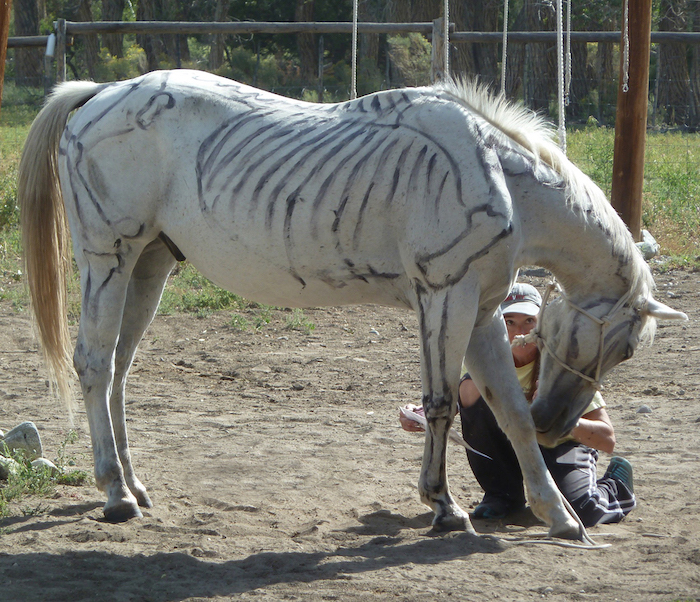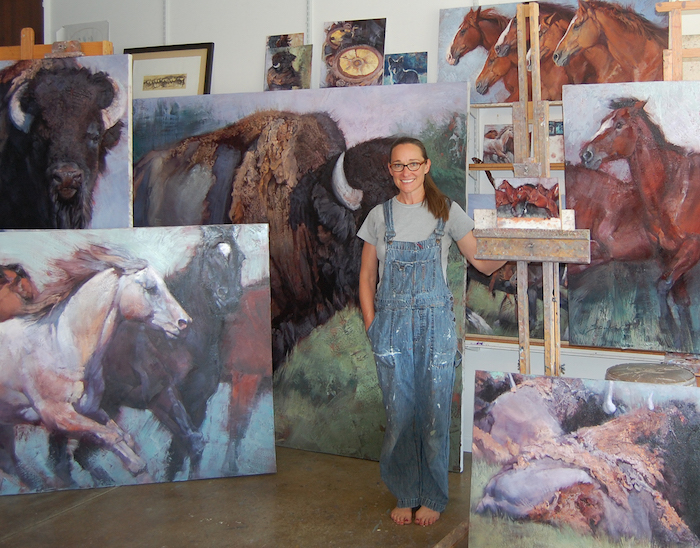Being profitable as an artist doesn’t necessarily mean you need to do more.
Sometimes it’s about doing less by being discerning about what you take on and where you invest your energy.

This is extremely difficult to do when you are trying to show and sell your art. You want to do more. To add new income streams and the latest marketing platforms. The ads and social media posts are encouraging you to do more.
But more is exhausting.
Jill Soukup, who has been a student and client of mine over the past decade, is my guest on this episode of the Art Biz Podcast. There are at least three things that I admire about Jill:
- She, above all, is dedicated to becoming a better artist. To methodically improving her work.
- She knows what she wants. How she wants her career, business, and life to be.
- She knows what she doesn’t want.
To this list I would add that she is generous, open, and an all-around nice person.
In this conversation, Jill and I discuss how and where she sells her work, how teaching fits in with her income plan, how she makes sure she remains profitable, and why it’s important for her to keep things simple.
Music by Wildermiss
Highlights
-
- Jill’s transition to full-time artist and where she shows and sells her art today. (1:51)
- The inspiration behind Jill’s Western-themed art. (5:56)
- Selling on Instagram is changing the dynamics of Jill’s work. (8:39)
- Logistics of selling prints and giving customers what they want. (11:34)
- Spending money to make money. (15:25)

- The strategies that allow Jill to get work done without working harder. (19:31)
- For Jill, doing less has resulted in even more success in her art business. (23:47)
- The hallmark of an exceptional artist: dedication to your craft and honing your skills. (29:10)
- Teaching, raising prices, and decreasing her painting output keeps Jill’s income steady. (30:45)
- Bookkeeping details and how Jill knows she is profitable. (37:24)
- Why is simplifying so important in Jill’s business—and life? (40:56)
- Insights from Jill’s typical work day and what she’s working toward now. (46:14)
Mentioned
Coors Western Art Exhibit & Sale

Jill Soukup Quotes
“As artists we ebb and flow in our process and what we’re producing.”
“This experience is teaching me to dig deeper and to see things that I wasn’t seeing before.”
“At that point I recognized that I was so overwhelmed. I wasn’t making any decisions because I had too many decisions to make.”
“At that moment I realized what really was important to me, and that all of the other things on my list were not even necessary.”
“Everything I chose to do had to meet one of my three goals and it just simplified everything. And it was such a beautiful thing.”
About My Guest

Jill Soukup was born in Buffalo, New York. Shortly thereafter, her family moved to Colorado, where she still resides. Jill’s affinity for horses as a young girl resulted in countless drawings and studies of them, which made for a strong drawing foundation. As a teen, she started a pet-portrait business, acquired jobs painting murals, and designed logos for local organizations.
Jill graduated from Colorado State University in 1991 with a Bachelor of Fine Art. There, she received awards for illustration and design and worked as an illustrator and designer for the university. She initially pursued a career in graphic design while continuing to paint part time. After 11 years as a designer, she made the switch to full-time painting. Her work continues to gain recognition as she receives awards, appears in national publications, and shows in important juried and one-woman exhibitions.
Follow Jill on Instagram: @jillsoukup
Music by Wildermiss



14 thoughts on “The Art Biz ep. 98: Being Profitable Doesn’t Have to Mean Doing More with Jill Soukup ”
I enjoyed this talk with Jill. She does lovely work but it is not by accident. She draws every day for practice. Her studio routine is set-no weekend work-I need to follow that good advice. Here’s to a cosmos on the front porch at the end of the workday! Well earned.
Meg: Yes to time off. You need it to find inspiration and incubate ideas.
I really enjoyed your conversation with Jill. As with nearly all your podcasts, I listened twice to enable it to sink in. I think what I liked most was her learner’s mindset – that to continue to grow as a professional, she must strive to keep learning.
Matt: That’s a terrific lesson to learn from this episode. Sounds like you, too, have the learner’s mindset.
I got so much out of this podcast – thank you!
I love that Jill can earn enough from selling her originals to live (hopefully well! Am I the only “inquiring mind” who wants to know what artists are earning from the sale of originals?!), and not have to teach that much (unless she wants to).
I love that she doesn’t work weekends!
And I find it very interesting how her subject matter picked HER – and keeps picking her.
Here’s to cosmos on the porch! Thanks, Alyson and Jill! 🙂
Keena: Yes, Jill is certainly an inspiration. As you know, it’s quite difficult to get artists to reveal their real income. I haven’t found the surveys done at the national level to be quite helpful. Back in episode 80, Betty Franks revealed that she sells more than $100k a year. I imagine that also includes her print sales, but that the majority is from originals. Listen to that episode.
I so enjoyed your conversation with Jill Soukup today. She was so openly genuine in her responses. I took notes….! Thank you Alyson, for continuing your business with such interesting, helpful and delightful podcasts. Thank you Jill for sharing.
Gwen: Don’t you love it when a podcast is so good that you take notes? I’d love to know what you found most interesting or helpful.
This was most excellent indeed!! Thank you very much. I have been a working fine artist all of my life, and it is good to hear how other artist succeed in organizing their art lives.
Thanks for listening, Eve. Really appreciate it.
This really spoke to me. I can also point to the book DRAWING ON THE RIGHT SIDE OF THE BRAIN, which was my jumping off point to really continue learning. By happenstance, I found a teacher (which I still take from 25 years later) that believes if you can sign your name, you can draw. This inspired me to incorporate blind contours into my morning meditation. Also – the story of her father’s stroke and learning about the brain and creativity is similar to me learning about music and memory and the brain’s capacity to remember music when all else fails. I too believe it is important to continue learning – and experimenting.
Vickie: I think you’re talking about the episode with Leah Smithson, who mentioned that book and her father’s stroke.
Great interview. The decision making dilemma was particularly interesting to me since I have the same issue. Big time. Thank you for the podcast!
Thanks for listening, Teresa. Decisions are my nemesis, but I know how critical it is to be able to make them confidently as a business owner.